
Ralph Basset, 2nd Baron Basset of Drayton (died 25 February 1343) was a 13th-14th century English nobleman who fought in both the Anglo-French War and in the First War of Scottish Independence.

Ralph Basset, 2nd Baron Basset of Drayton (died 25 February 1343) was a 13th-14th century English nobleman who fought in both the Anglo-French War and in the First War of Scottish Independence.
Basset was the son of Ralph Basset and Hawise [2] . Ralph succeeded his father on his death on 31 December 1299, [3] and was knighted on 22 May 1306. [3]
Distinguishing himself in France, Ralph was appointed to the office of Seneschal of Gascony on 11 June 1323, also serving as the Steward of the Duchy of Aquitaine.
Within the first four months of holding office in Gascony, the Gascon nobleman Raymond-Bernard de Montpezat raided Saint-Sardos and hanged a royal sergeant of King Charles IV of France. Basset was within the village's vicinity when de Montpezat raided Saint-Sardos and the two had met only two days earlier. The French assumed Basset was complicit in the raid. King Edward II of England sent forth an apology to the French king, declaring his innocence. Basset was summoned to Bergerac, but he declined to appear and replied with unconvincing excuses. While Charles IV was inclined to accept Edward II's excuses, he was determined to try Basset and de Montpezat, though neither appeared in court and they were outlawed and their property forfeited to the French crown. [4] By 15 March 1324, Basset was recalled to England and removed from his office, [4] though he was briefly reappointed from 21 July to 18 November 1324.
Basset held the office of Constable of Dover Castle between March and September 1326 as well as the office of Warden of the Cinque Ports during the same time. Ralph was created a Knight Banneret in 1341 and died in 1343.
Ralph married Joan, the daughter of John de Grey of Wilton and Matilda de Verdun. They obtained a marriage license on 27 March 1304 to wed. They are known to have had the following issue: [3]
He was succeeded in the barony by his grandson, Ralph, the son of Ralph (died 1335) who predeceased him.

Year 1323 (MCCCXXIII) was a common year starting on Saturday of the Julian calendar.

Year 1324 (MCCCXXIV) was a leap year starting on Sunday of the Julian calendar.

Charles II, known as the Bad, was King of Navarre beginning in 1349, as well as Count of Évreux beginning in 1343, holding both titles until his death in 1387.
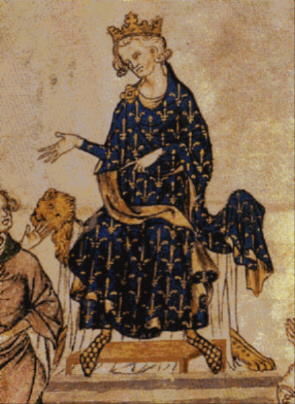
Philip VI, called the Fortunate or the Catholic and of Valois, was the first king of France from the House of Valois, reigning from 1328 until his death in 1350. Philip's reign was dominated by the consequences of a succession dispute. When King Charles IV of France died in 1328, his nearest male relative was his nephew, King Edward III of England, but the French nobility preferred Charles's paternal cousin, Philip.

Charles IV, called the Fair in France and the Bald in Navarre, was last king of the direct line of the House of Capet, King of France and King of Navarre from 1322 to 1328. Charles was the third son of Philip IV; like his father, he was known as "the fair" or "the handsome".

The Battle of Neville's Cross took place during the Second War of Scottish Independence on 17 October 1346, half a mile to the west of Durham, England. An invading Scottish army of 12,000 led by King David II was defeated with heavy loss by an English army of approximately 6,000–7,000 men led by Ralph Neville, Lord Neville. The battle was named after an Anglo-Saxon stone cross that stood on the hill where the Scots made their stand. After the victory, Neville paid to have a new cross erected to commemorate the day.
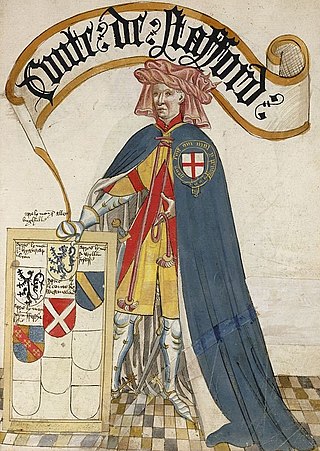
Ralph de Stafford, 1st Earl of Stafford, 2nd Baron Stafford, KG, of Stafford Castle and Madeley Castle in Staffordshire, was an English nobleman and a notable soldier during the Hundred Years' War against France.
Margaret of Norfolk or Margaret of Brotherton, Duchess of Norfolk in her own right, was the daughter and eventual sole heir of Thomas of Brotherton, eldest son of King Edward I of England by his second marriage. In 1338, she succeeded to the earldom of Norfolk and the office of Earl Marshal. In 1397, she was created Duchess of Norfolk for life.
The War of Saint-Sardos was a short war fought between the Kingdom of England and the Kingdom of France in 1324 during which the French invaded the English Duchy of Aquitaine. The war was a clear defeat for the English and led indirectly to the overthrow of Edward II of England. It can also be seen as one of the precursors to the Hundred Years' War.
Amanieu VII was the Lord of Albret from 1298 until his death; the son of Amanieu VI.
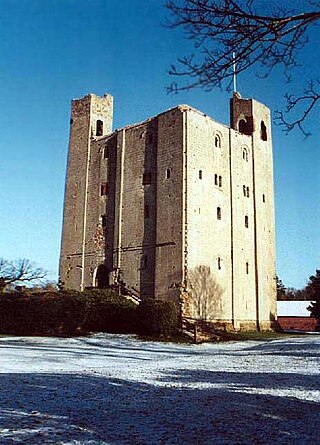
John de Vere, 7th Earl of Oxford was the nephew and heir of Robert de Vere, 6th Earl of Oxford who succeeded as Earl of Oxford in 1331, after his uncle died without issue.
The Second War of Scottish Independence broke out in 1332, when Edward Balliol led an English-backed invasion of Scotland. Balliol, the son of former Scottish king John Balliol, was attempting to make good his claim to the Scottish throne. He was opposed by Scots loyal to the occupant of the throne, eight-year-old David II. At the Battle of Dupplin Moor Balliol's force defeated a Scottish army ten times their size and Balliol was crowned king. Within three months David's partisans had regrouped and forced Balliol out of Scotland. He appealed to the English king, Edward III, who invaded Scotland in 1333 and besieged the important trading town of Berwick. A large Scottish army attempted to relieve it but was heavily defeated at the Battle of Halidon Hill. Balliol established his authority over most of Scotland, ceded to England the eight counties of south-east Scotland and did homage to Edward for the rest of the country as a fief.
Sir Thomas Coke, Seneschal of Gascony, was a 14th-century English noble.
The Seneschal of Gascony was an officer carrying out and managing the domestic affairs of the lord of the Duchy of Gascony. During the course of the twelfth century, the seneschalship, also became an office of military command. After 1360, the officer was the Seneschal of Aquitaine. There was an office above the seneschalcy, the Lieutenancy of the Duchy of Aquitaine, but it was filled only intermittently.
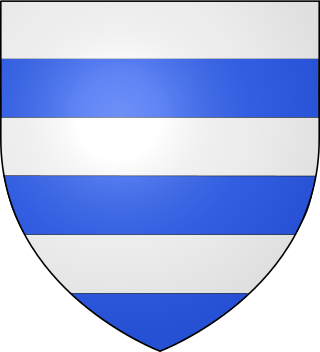
Richard Grey, 2nd Baron Grey of Codnor, of Codnor Castle, was an English soldier and diplomat.

Richard Stafford, 1st Baron Stafford of Clifton, Lord of Clifton, was an English soldier and diplomat during the Hundred Years' War. He was the second son of Edmund Stafford, 1st Baron Stafford and Margaret Basset, and the younger brother of Ralph Stafford, 1st Earl of Stafford.

Sir John Harpeden was an English knight and administrator who served Edward III of England in France during the Hundred Years' War. He served as seneschal of Saintonge (1371–72) and seneschal of Aquitaine (1385–89). His descendants became French lords. He is called John Harpeden I or John Harpeden the Elder to distinguish him from his son, Jean Harpedenne II.
Sir John de Wisham of Little Ellingham, was an English knight and administrator who served as Constable of St Briavels Castle, Justice of North Wales, Seneschal of Gascony (1324–1325) and Captain of Berwick-upon-Tweed (1316).
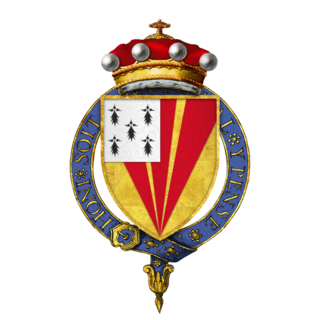
Ralph Basset, 3rd Baron Basset of Drayton KG was a medieval English soldier knight, one of the earliest-appointed Knights of the Garter.

Walter FitzWalter, 3rd Baron FitzWalter was an English soldier and nobleman.